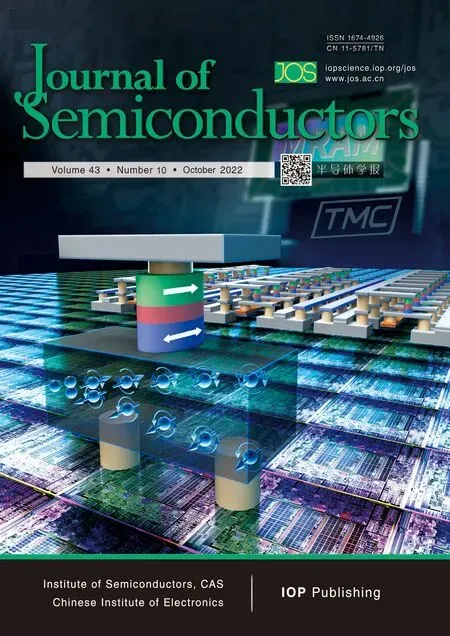Superfluorescence from halide perovskite nanocrystal superlattices
2022-11-25LiangChuLixiuZhangandLimingDing
Liang Chu ,Lixiu Zhang ,and Liming Ding,
1School of Electronics and Information,Hangzhou Dianzi University,Hangzhou 310018,China
2Center for Excellence in Nanoscience (CAS),Key Laboratory of Nanosystem and Hierarchical Fabrication (CAS),National Center for Nanoscience and Technology,Beijing 100190,China
Progress has been made in accurately manipulating the size and shape of monodisperse nanocrystals over past 30 years.In 1993,Bawendiet al.synthesized monodisperse CdS,CdSe and CdTe nanocrystals with similar size by a hot-injection method[1].After two years,they prepared CdSe nanocrystal superlattices by self-assembling method with two distinct morphologies: faceted colloidal crystals and ordered thin films.The size and spacing of nanocrystals were controlled with a nearly atomic precision[2].Then,engineering morphology,interaction and surrounding environment are encouraged to construct superlattices at atomic scale.Meanwhile,the advanced technologies like electron microscopy and Xray related tools help scientists to deeply understand the structures and properties of nanocrystal superlattices[3].Compared to individual nanocrystal,their superlattices indicate collective properties due to coupling between nanocrystals[4].For instance,their original properties are enhanced because the ordered nanocrystals interact with each other under the light,electric or magnetic field;new properties can be generated by the periodically ordered structures of the assembly;and comprehensive properties can be obtainedviaassembling nanocrystals with different functions.
Halide perovskite nanocrystals rapidly advances in recent years due to the tunable bandgaps,narrow emission,high photoluminescence quantum yields,and short radiation lifetime.They can be synthesized by a hot-injection method with narrow-distributed sizes,yielding nanoscale building blocks of superlattices.Especially,CsPbBr3nanocrystal superlattices attract wide attention because of the minibands caused by electronic coupling between neighboring nanocrystals[5],low-threshold two-photon-induced gain[6],long-range exciton diffusion[7],tunable anisotropic light emission,and superfluorescence[8].Superfluorescence is a collective emission from lots of light-excited individual dipoles unlike fluorescence.By exchanging virtual photons,the quantum states of dipoles spontaneously synchronize and are excited together,yielding a strong emission,called superfluorescence.Its intensity is much stronger than the sum of individual emitters.
CsPbBr3nanocrystals self-assembled into structurally well-defined,long-range ordered,and densely-packed cuboidal superlattices on silicon substrates by a solvent-dryinginduced process,indicating quantum coherence for emitting superfluorescence[8].Till now,superfluorescence was only observed in a very few systems because of the stringent producing conditions,e.g.high oscillator strength,low inhomogeneity,small exciton dephasing.Cubic CsPbBr3nanocrystals with a mean size of 9.5 nm can moderate quantum-confinement effect,offering narrow-band emission.The superlattices exhibited dynamically red-shifted emission peak with more than 20-fold accelerated radiative decay,extension of the first-order coherence time by more than a factor of four and photon bunching.Moreover,the superfluorescence decay demonstrates Burnham-Chiao ringing behavior at high excitation density,reflecting the coherent Rabi interaction.This iconic work provides potential candidates for high-brightness and multi-photon quantum light sources,enabling the utilization of coupling effects for long-range quantum transport and ultra-narrow tunable lasers.
In 2020,Zhouet al.generated a quantum coherence of dipoles in CsPbBr3nanocrystal superlattice and tuned the ultrafast radiation of the quantum systems by introducing optical microcavities[9].The stimulated radiation in the superlattice microcavity was not limited by classical population-inversion condition,resulting in the dissipation of all in-phase dipoles in picoseconds.The highly symmetric and long-range ordered superlattice microcavity could have characteristics of both superfluorescence and stimulated radiation to realize cavity-enhanced superfluorescence (CESF).Compared to monodisperse CsPbBr3nanocrystals (~12 ns),the irradiation time of superfluorescence (~30 ps) was shortened by~400 times,while that for CESF (~4 ps) was shortened by~3000 times.Then,the essential difference between CESF and classical lasers was analyzed through a number of experiments.In classical lasers,excitons radiate rapidly above the threshold density,and radiate slowly below the threshold density.While in CESF,excitons have collaborative quantum states,and all dipoles in the same phase dissipate rapidly by a single pulse.Based on the quantum properties of cooperative excitons,a perovskite nanocrystal superlattice microcavity was proposed as a THz quantum container.The excited light can quickly induce carriers with high concentration,and the cooperative state is quickly established spontaneouslyviaexchanging virtual photons,called the “Filled” state.When the relaxation channel of CESF opens,the quantum container is quickly emptied,called the “Void” status.
In 2021,ABX3superlattices were createdviashape-directed co-assembly of binary or ternary elements,analogous to the lattice structure of ionic perovskites[10].A,B and X positions are required to form nanocrystals for the single-component superlattices.In binary ABX3superlattice,larger spherical Fe3O4or NaGdF4nanocrystals occupy A sites,while smaller cubic CsPbBr3nanocrystals locate at B and X sites.Tiny change in sizes and fractions of spherical Fe3O4and cubic CsPbBr3nanocrystals can transform NaCl-type to ABX3-type binary superlattices.In ternary ABX3superlattice,B position is replaced by truncated cubic PbS nanocrystals.The respective nanocrystal sizes are carefully adjusted in ternary superlattices consisting of cubic CsPbBr3nanocrystals,spherical Fe3O4nanocrystals and truncated cubic PbS nanocrystals,which can assemble to fill~92% of the space.The spherical nanocrystals exhibit random orientation.While cubic CsPbBr3nanocrystals exhibit highly ordered orientation in all superlattices,giving the superfluorescence.ABX3-type superlattices offer strong collective emission than NaCl-type superlattices,due to stronger coherent coupling.The superfluorescence features ultrafast radiative decay (22 ps) and Burnham-Chiao ringing behavior.
Superfluorescence was observed at extremely low temperature,because the synchronized dipoles can be disturbed by thermal noise.In 2022,room-temperature superfluorescence was discovered in quasi-2D PEA:CsPbBr3films[11].The long PEA cations separate PbI6octahedra layers to form quantumwell structures,which can be considered as 2D hybrid perovskite superlattices.The electronic coherence time for PEA:CsPbBr3films is at least two orders of magnitude longer than that of inorganic semiconductors.Large electronic dipoles have strong coupling to protect quantum coherence at temperature as high as 300 K.
In short,quantum coherence yields superfluorescence.However,the superfluorescent superlattice is only found in highly-oriented CsPbBr3-containing assembly so far,more perovskite superlattices need to be developed.Future research will involve perovskite materials[12],perovskite crystallization[13],perovskite nanocrystals[14],stimulated emission[15],and probably applications in light-emitting diodes[16].
Acknowledgements
This work was supported by the National Natural Science Foundation of China (52172205).L.Ding thanks the open research fund of Songshan Lake Materials Laboratory(2021SLABFK02),the National Key Research and Development Program of China (2017YFA0206600) and the National Natural Science Foundation of China (51922032,21961160720).
杂志排行
Journal of Semiconductors的其它文章
- Synthesis and electromagnetic transport of large-area 2D WTe2 thin film
- 26.75 cm2 organic solar modules demonstrate a certified efficiency of 14.34%
- A deep trench super-junction LDMOS with double charge compensation layer
- Multilayer doped-GeSe OTS selector for improved endurance and threshold voltage stability
- Identification of subsurface damage of 4H-SiC wafers by combining photo-chemical etching and molten-alkali etching
- Integration of high-performance spin-orbit torque MRAM devices by 200-mm-wafer manufacturing platform
